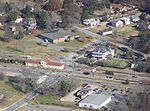Lee Hall Depot
1881 establishments in VirginiaBuildings and structures in Newport News, VirginiaFormer Chesapeake and Ohio Railway stationsLandmarks in VirginiaMuseums established in 2021 ... and 8 more
Museums in Newport News, VirginiaNational Register of Historic Places in Newport News, VirginiaQueen Anne architecture in VirginiaRailroad museums in VirginiaRailway stations in the United States opened in 1881Railway stations on the National Register of Historic Places in VirginiaTransportation in Newport News, VirginiaTransportation in Virginia

Lee Hall Depot is a historic train station and museum located in the Lee Hall neighborhood of Newport News, Virginia. It was built in about 1881, with a one-story cargo bay, and the two-story main section was added in 1893. Another one-story wing was added by the Chesapeake and Ohio Railway to the north end of the depot in 1918 to handle an influx of military personnel to Fort Eustis. The building is currently in use as a local history museum, focusing on the station's history, and the history of the Chesapeake & Ohio Railroad in Warwick County.
Excerpt from the Wikipedia article Lee Hall Depot (License: CC BY-SA 3.0, Authors, Images).Lee Hall Depot
Elmhurst Street,
Geographical coordinates (GPS) Address Phone number Website External links Nearby Places Show on map
Geographical coordinates (GPS)
| Latitude | Longitude |
|---|---|
| N 37.194444444444 ° | E -76.5725 ° |
Address
Lee Hall Train Depot
Elmhurst Street 9
23603 , Lee Hall
Virginia, United States
Open on Google Maps






